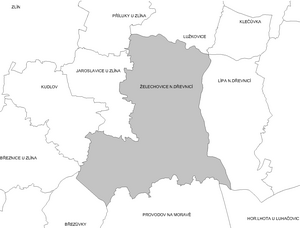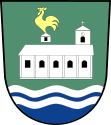Želechovice nad Dřevnicí
| Želechovice nad Dřevnicí | ||||
|---|---|---|---|---|
|
||||
| Basic data | ||||
| State : |
|
|||
| Region : | Zlínský kraj | |||
| District : | Zlín | |||
| Area : | 1603 ha | |||
| Geographic location : | 49 ° 13 ' N , 17 ° 45' E | |||
| Height: | 242 m nm | |||
| Residents : | 1,865 (Jan 1, 2019) | |||
| Postal code : | 763 11 | |||
| License plate : | Z | |||
| traffic | ||||
| Street: | Zlín - Vizovice | |||
| Railway connection: | Otrokovice – Vizovice | |||
| structure | ||||
| Status: | local community | |||
| Districts: | 1 | |||
| administration | ||||
| Mayor : | Michal Špendlík (as of 2010) | |||
| Address: | ulice 4. května 68 763 11 Želechovice nad Dřevnicí |
|||
| Municipality number: | 500011 | |||
| Website : | www.zelechovice.net | |||
| Location of Želechovice nad Dřevnicí in the Zlín district | ||||

|
||||
Želechovice nad Dřevnicí , until 1924 Želechovice (German Schelechowitz an der Drewnitz , formerly Zelechowitz ) is a municipality in the Czech Republic . It is located six kilometers east of Zlín and belongs to the Okres Zlín .
geography
Želechovice nad Dřevnicí is located on the edge of the Vizovická vrchovina and Želechovické paseky nature parks in the Vizovice Uplands . The village extends on the left bank of the Dřevnice at the confluence of the Obůrek brook. The Tlustá hora (482 m) and the Drdol (540 m) rise to the southeast, the Díly (308 m) to the south and the Lysá (387 m) to the southwest. The state road I / 49 between Zlín and Vizovice and the Otrokovice – Vizovice railway run through the village .
Neighboring towns are Lužkovice in the north, Veselá and Klečůvka in the Northeast, Lipa in the east, Na Potůčkách, Na Kolibe, Cikánky, Želechovické Paseky, Slopné and Horni Lhota in the southeast, Obůrky, Nad Kouty and Provodov in the south, Jaroslavické Paseky, Vavrušky and Jaroslavice in Southwest, Pančava and Zlín in the west and Výpusta, Příluky and Štákovy Paseky in the northwest.
history
The first written mention of the village Selichowicz was made in 1261 in the founding deed of the Smilheim monastery in Vizovice . Thereafter, Wilhelm von Hustopeče gave the Cistercians the village of Lípa and part of Selichowicz and Zádveřice. However, the greater part of Selichowicz belonged to the rule Zlín . The Obůrek brook formed the border between the Zlín and Smilheim parts. In 1361 the village was named Zelithowicz , 1397 Selythohowicz and 1437 Zelechowicz . After the fall of the monastery, Zigmund Kuna von Kunstadt , a descendant of the monastery founder, received the monastic property for the purpose of renovating the monastery, which however never took place. The place name is passed down as Zylochowicze from 1490 and again as Zelechowicz four years later . In 1518 the village was named Zielichowicz . Other forms of name were Zielechowicze (1578), Ziellochowitz (1580), Zielychowicze (1596), Zelechowicz (1672) and Zielechowitz or Želechowitz (1718). After the majority of the residents had become Protestant in the second half of the 16th century, a Protestant pastor was appointed in addition to the Catholic pastor, and finally the parish became entirely Protestant. The Vizovi share consisted of twelve farms in 1585. The parish expired in 1620 and the village was parish to Zlín or Vizovice. In 1644, four residents from Želechovice were hanged after the Wallachian Uprising was put down. After the Thirty Years War, the subjects were recatholicized, which was more successful in Želechovice than in the surrounding villages. There is evidence of a parish school in Želechovice since 1656. In 1660 the village was hit by a severe flood. In the Zlín part, 17 farmed properties are recorded for 1667, many more were in desolation. When the Kuruc invaded the village at the beginning of the 18th century, it was devastated. In 1726 the Vizovice manors restored the manorial paper mill in Želechovice for 1756 guilders. In 1755 the paper mill was sold to the Halda family of papermakers, who owned it until 1881. In August 1748 the owners of the gentlemen joined Světlov , Luhačovice , Zlín, Vizovice and lexical borrowings Vasilsko Forsthaus Vidovy a comparison on border demarcation in Vizovice highlands . Because of the resulting disadvantages, the Pasekaren in particular rebelled on the Luhačovice and Vizovice territory in 1766 and tore up the new boundary stones. With the support of the army, on December 15, 1767, the new borders were forcibly restored. Several hundred people gathered against the action starting in Želechovice. The riot was put down by the military, leaving four dead and many injured. Ultimately, the border recession was confirmed by the court in May 1772 and the claimed rights to the forests were revoked from the villages. Registries have been kept since 1750, the land registers since 1758. Since 1756 there was a parish exposition in Želechovice, which was elevated to a locality in 1785. In 1790 the village consisted of 100 houses and had 625 inhabitants. Of the 164 families in Želechovice, 159 made a living from agriculture; there were also three craftsmen as well as the pastor and the teacher. In 1843 the village had grown to 145 houses in which 742 people lived. In the same year in Želechovice its own parish was established again. In 1846 the village was named as Ziellochwitz , Želechowice and Zelechowice . Until the middle of the 19th century, Želechovice was always divided between the Zlín and Vizovice lords.
After the abolition of patrimonial Zelechowice / Zelechowitz formed from 1850 a municipality in the district administration Uherský Brod . From 1855 the village belonged to the Vizovice District and from 1868 to the Holešov District . Between 1867 and 1868 a new school building was built. In 1869 the village had 814 inhabitants and in 1880 there were 907. In 1872 the municipality was named Zelechwitz or Želechowice and in 1881 Želichovice . In 1899 the Otrokovice – Vizovice railway was inaugurated, the station was initially named Lůžkovice . The current form of the name Želechovice originated at the beginning of the 20th century. In 1920 the Baťa group bought the paper mill. In 1921 Želechovice had 982 inhabitants, of which 836 were Catholic, 123 were Protestant, eleven confessed to the Czechoslovak Hussite Church and twelve were non-denominational. Almost all of the residents were Czech. In 1923 the paper mill burned down and was not rebuilt.
Since 1924 the municipality has had the official name Želechovice nad Dřevnicí . During this time, the municipality benefited from the upswing of the city of Zlín and by 1930 already had 1280 inhabitants. 1935 Želechovice nad Dřevnicí was assigned to the new Zlín district. In 1949 the citizen school was inaugurated. In 1950 there were 1658 people living in the place. From 1950 Želechovice nad Dřevnicí belonged to the Okres Gottwaldov-okolí and from 1960 back to the Okres Gottwaldov, which has been called Okres Zlín again since 1990 after the political change . On June 1, 1960 Lužkovice and Lípa were incorporated. In 1961 Želechovice nad Dřevnicí had 1835 inhabitants. In 1976 it was incorporated into Gottwaldov . In 1980 Želechovice nad Dřevnicí lived 2059 people, in 1991 it was 1978. On May 17, 2008, the residents of Želechovice nad Dřevnicí decided in a referendum with 77.5% of the votes for the formation of their own municipality. On January 1, 2009 Želechovice nad Dřevnicí broke away from Zlín. Since 2010, Želechovice nad Dřevnicí has had a coat of arms and a banner. Želechovice nad Dřevnicí is a Catholic parish for Lípa, Lužkovice and Klečůvka.
Local division
No districts are shown for the municipality of Želechovice nad Dřevnicí. Želechovice nad Dřevnicí includes u. a. the settlements of Batalice, Laze, Nad Kouty, Obůrky, Oslné, Vidova, Želechovické Paseky, Zelené Údolí and Žleby.
Attractions
- Parish church of St. Peter and Paul, it was built in 1737 on the remains of a medieval church
- Memorial to the victims of the Second World War
- Natural monument Pod Drdolem, southeast near Želechovické Paseky
- Zelené údolí natural monument, south of the village in the Obůrek valley
- Nature reserve Na Želechovických pasekách, south of Obůrky
Individual evidence
- ↑ Český statistický úřad - The population of the Czech municipalities as of January 1, 2019 (PDF; 7.4 MiB)


